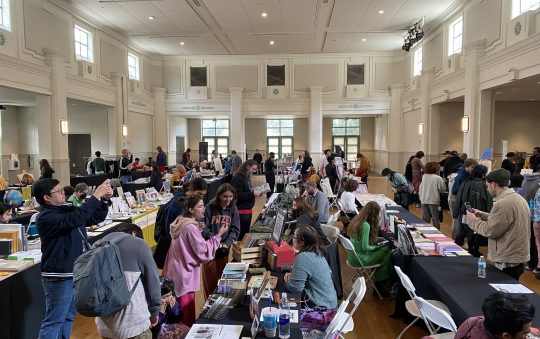
- Gabrielle Starr, a highly regarded scholar of English literature whose work reaches across neuroscience and the arts, has been selected as the 10th president of Pomona College.
Dean of New York University’s College of Arts and Science, Starr leads NYU’s 7,000-student undergraduate liberal arts college, oversees its $130 million budget, and coordinates undergraduate experience across 55 departments and programs. She has led the development of new cohort and first-year programs, helping to create scholarly communities for undergraduates in the arts and sciences.
Her collegiate work began at the age of 15, when she set off to study at Emory University before going on to earn her Ph.D. from Harvard University. She then launched into a dynamic and varied career combining science and the humanities, intensive research and campus leadership.
“It’s a great honor to join Pomona’s extraordinary community of scholars and researchers, artists and activists, educators and entrepreneurs,” said Starr. “The life of the mind speaks to a deep human need, and we are truly fortunate to be able to pursue the true breadth of human knowledge in a vibrant and open atmosphere.
“I look forward to working together with you as we let Pomona’s light shine for another generation, and, together, shape our world anew.”
Appointed this month in a vote by the Pomona College Board of Trustees, Starr will succeed President David W. Oxtoby, who announced earlier this year that he would be stepping down June 30, 2017 after what will be 14 years leading the College.
Starr will be the first woman and the first African American president of Pomona College, one of the nation’s premier liberal arts institutions. Her inclusive leadership style along with her distinguished academic work connecting multiple disciplines epitomize key values of the College, said Sam Glick, chair of the Pomona College Board of Trustees.
“Gabi embodies the liberal arts, and will bring to Pomona’s presidency her characteristic intellect, vision and humanity,” says Glick. “Gabi is an extraordinary leader who will build on the legacy of President Oxtoby and his predecessors as she helps us to write the next chapter of our history.”
A scholar of 18th-century British literature, Starr’s recent research in aesthetics has helped open new paths of scientific inquiry at the intersection of aesthetics and neuroscience, studying how we think about, and how our bodies respond to, music, painting and poetry.
Her most recent book, “Feeling Beauty: The Neuroscience of Aesthetic Experience,” (MIT Press, 2013) was a finalist for the Phi Beta Kappa Society’s 2014 Christian Gauss Award. Starr was named a Guggenheim Fellow in 2015, and her work also has been supported by the Andrew W. Mellon Foundation’s New Directions Fellowship and a National Science Foundation ADVANCE grant.
Along with pursuing research, Starr has been an academic leader for most of her scholarly career, serving as NYU’s English Department chair and as director of undergraduate studies before becoming acting dean of the College of Arts and Science in 2011, with the interim role becoming permanent two years later.
A member of NYU’s senior leadership team, Starr co-chairs the university task force on equity, diversity and inclusion, as well as the university-wide task force on preventing sexual violence.
Starr has worked actively to expand access to higher education in New York. She partnered with New York City’s largest community college to create a pipeline in STEM education and a faculty partnership focused on the global humanities. She is also particularly proud of her role in co-founding a cross-university prison education program (funded generously by the Ford Foundation), offering A.A. degrees in the liberal arts to students in a medium-security prison in New York State.
Starr’s commitment to higher education includes service on the Board of Trustees of Ithaca College.
Starr’s dedication to academic excellence, equity and opportunity has deep roots in her childhood growing up in Tallahassee, Florida.
Education was always a core value: both of her parents grew up in the deeply segregated South, yet sought social change through education. Her mother, Barbara Starr, taught high school English and American history. Her father, G. Daviss Starr, would earn his college degree at the age of 40 and eventually go on to become a professor at Florida A&M.
Along the way, he became a public school teacher, encountering the reality that many of his students couldn’t get homework help from their parents, who were often unable to read. So he set out to earn a Ph.D. at the University of Michigan, studying the psychology of literacy, hoping to help spark institutional change in the South.
“He taught me that the best way to make change was to find the root causes, and if you want to have an effect in the world you have to look beyond the people who are right in front of you to those who are behind them and behind them to see where you can give the right push and make the world better,” says Starr of her late father.
While circumstances led her father to start college later in life, Starr began unusually early, setting off as an undergraduate at the age of 15, choosing Emory University (Atlanta was as far as her parents felt comfortable letting her go).
Though younger than her class, Starr thrived in undergraduate residential life, building close connections with classmates and rugby friends that last to this day.
She started at Emory planning to major in chemistry and become a doctor – that seemed like the thing to do. But the then-emerging field of women’s studies drew her in, and that discipline would be the source of her B.A. and M.A at Emory. She also spent a year at St. Andrew’s University in Scotland as a Bobby Jones Scholar, studying philosophy of language, Arabic and French, while becoming fascinated with French classicism.
Accepted to Harvard for her Ph.D., she began to explore 18th-century ideas of the imagination. One of the benefits of studying this time period in British history, Starr notes, is that it preceded the emergence of the modern academic disciplines.
“So my intellectual history has really been that the disciplines provide particular tools,” says Starr. “But they don’t necessarily exist in isolation from one another.”
This insight from the past offered a worthy path for today’s increasingly interdisciplinary world.
After earning her Ph.D. in English and American literature from Harvard, Starr went on to a post-doctoral fellowship at Caltech and the Huntington Library, at a time when cognitive neuroscience was beginning to flourish. Delving into the science, she began to look at imagination and the effects of the arts from the perspective of that new field. Shortly after she arrived at NYU in 2000, a New Directions fellowship from the Mellon Foundation allowed her to pursue deeper study in neuroscience, and her scholarly work has focused on its intersection with aesthetics ever since.
Now comes another new direction as Starr takes the helm at Pomona College. It is worth noting that the scholar of British literature whose work shifted into cognitive neuroscience will succeed David Oxtoby, a chemist who has made promoting creativity and the arts a key focus of his presidency.
“Pomona’s a place where you’re always looking for an intellectual connection that goes beyond your immediate area of focus,” says Starr. “That open-mindedness and willingness to engage across disciplinary boundaries is both fundamental to Pomona and to the spirit of the liberal arts as a whole.”




